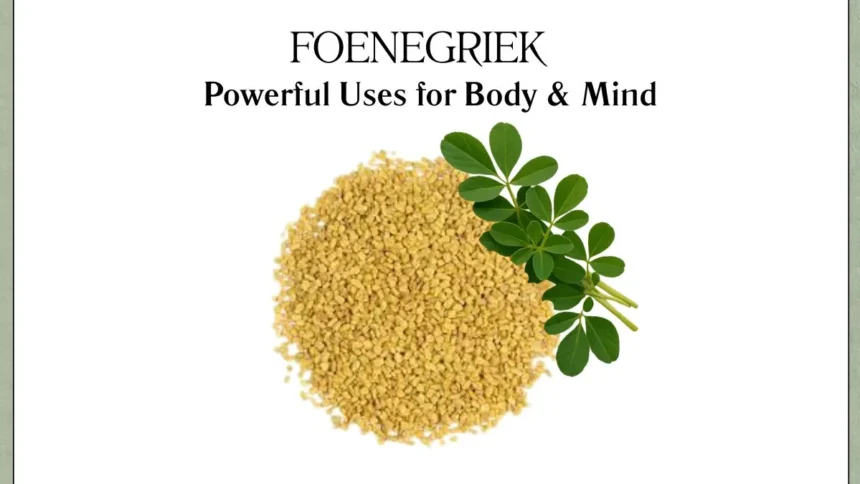Foenegriek, the Dutch word for fenugreek, refers to the seeds and leaves of the plant Trigonella foenum-graecum, a member of the legume (Fabaceae) family. With origins in the Mediterranean, South Asia, and North Africa, foenegriek has travelled far beyond its native lands to become a globally recognised spice and medicinal herb. From flavouring curries and breads to supporting digestive health and regulating blood sugar, foenegriek stands as a bridge between the culinary world and natural medicine.
A Brief History of Foenegriek
The history of foenegriek stretches back thousands of years. Ancient Egyptians used it in embalming rituals and herbal remedies. In Ayurvedic and Chinese medicine, its seeds were prized for their warming, digestive, and strengthening properties. The Greeks and Romans also integrated fenugreek into their diets and treatments, recognising its potential as both a spice and a healing plant.
Today, it is cultivated worldwide, particularly in India, Pakistan, Egypt, and parts of Europe, including the Netherlands, where its Dutch name, foenegriek, has entered both herbal and culinary vocabularies.
What Makes Foenegriek Unique?
Foenegriek seeds are small, hard, and yellow-brown, with a distinctive bitter-nutty taste that mellows when roasted. The dried or fresh leaves, often called methi in South Asia, carry an earthy aroma that enhances stews, teas, and flatbreads. Unlike many spices, it is not only valued for its flavour but also for its rich nutritional and bioactive profile, making it a rare combination of seasoning and medicine.
Nutritional Profile of Foenegriek
It is a powerhouse of nutrients. A single tablespoon of seeds provides:
- Protein: essential for muscle growth and repair
- Dietary fibre: supports digestion and gut health
- Iron and magnesium: crucial for energy and metabolism
- Manganese, copper, and phosphorus: vital for cellular health
- Vitamins A, C, B6, and folate: supporting immunity and neurological function
What sets foenegriek apart are its bioactive compounds, including saponins, alkaloids, flavonoids, and galactomannans. These contribute to its therapeutic roles in blood sugar regulation, lactation support, and metabolic health.
Culinary Uses of Foenegriek
It has an irreplaceable role in many cuisines:
- Indian cuisine: Seeds are dry-roasted or fried in oil to add depth to curries, dals, and pickles. Fresh leaves (methi) are used in parathas, curries, and lentil soups.
- Middle Eastern cuisine: Added to spice blends, stews, and herbal teas.
- North African cuisine: Essential in the berbere spice mix and used in breads.
- European herbal teas and breads: In the Netherlands and Germany, its seeds are sometimes added to herbal teas or used as a natural flavouring in rye breads.
Its versatility makes it both a flavour enhancer and a nutritive addition to daily diets.
Medicinal Benefits of Foenegriek
It is more than just a spice; it has been regarded as a natural remedy across multiple traditional medicine systems. Modern science now supports many of its uses.
Supports Digestion
- The high fibre content aids in relieving constipation and improving gut motility.
- Foenegriek teas and extracts help soothe heartburn and indigestion.
Regulates Blood Sugar
- Rich in soluble fibre, it slows carbohydrate absorption, helping to stabilise blood glucose.
- Studies suggest it supplementation benefits individuals with type 2 diabetes and insulin resistance.
Enhances Lactation
- Nursing mothers have long used its seeds to boost breast milk production.
- Compounds in foenegriek act as galactagogues, stimulating milk flow.
Supports Weight Management
- Fibre-rich seeds help increase satiety, reducing overall calorie intake.
- Extracts may aid in metabolism regulation.

Improves Heart Health
- Regular consumption of it can lower cholesterol and triglyceride levels.
- Its antioxidant properties protect cardiovascular tissues.
Anti-Inflammatory and Antioxidant Effects
- Saponins and flavonoids in it combat oxidative stress.
- Traditionally used for arthritis and skin inflammations.
Hormonal and Reproductive Health
- Some evidence suggests it may support natural testosterone levels in men.
- Used in women’s health to regulate menstrual discomfort.
How to Use Foenegriek in Daily Life
- Soaked seeds: Drinking it water (seeds soaked overnight) aids digestion and metabolism.
- Powdered seeds: Added to smoothies, curries, or baked goods.
- Foenegriek tea: Steeping seeds for a warm, medicinal beverage.
- Capsules and extracts: Available as supplements for targeted health benefits.
- Topical paste: Ground seeds mixed with water for skin and hair care.
Safety and Precautions
While it is generally safe, it should be consumed mindfully:
- Pregnant women should avoid excessive intake due to the uterine stimulation effects.
- It may interact with blood-thinning medications or diabetes medicines, so consult a healthcare provider before use.
- Overconsumption can cause gastrointestinal discomfort or a maple-syrup-like odour in sweat and urine.
Foenegriek in Modern Wellness Trends
With the rise of functional foods and herbal remedies, it is gaining recognition beyond traditional medicine. It is now integrated into nutraceuticals, protein powders, hair care products, and herbal supplements, making it a versatile ingredient in modern lifestyles.
In the Netherlands, it continues to symbolise the merging of culinary tradition with holistic health, showcasing how a simple spice can have powerful impacts.
FAQs
Q1.What is the difference between foenegriek and fenugreek?
They are the same plant. Foenegriek is the Dutch word for fenugreek.
Q2. Can I eat foenegriek seeds raw?
Yes, but soaking or roasting them improves flavour and digestibility.
Q3. Is foenegriek safe for long-term use?
Yes, when consumed in moderate amounts as food. For supplements, consult a healthcare professional for safe dosage.
Conclusion
Foenegriek, the Dutch name for fenugreek, is more than just a spice; it is a culinary treasure and a medicinal ally. From enhancing the flavour of curries and breads to supporting digestion, lactation, heart health, and blood sugar regulation, this ancient plant continues to prove its relevance in modern times.
Whether added to your kitchen shelf or integrated into your wellness routine, foenegriek stands as a reminder of how nature provides both nourishment and healing in one small seed.






